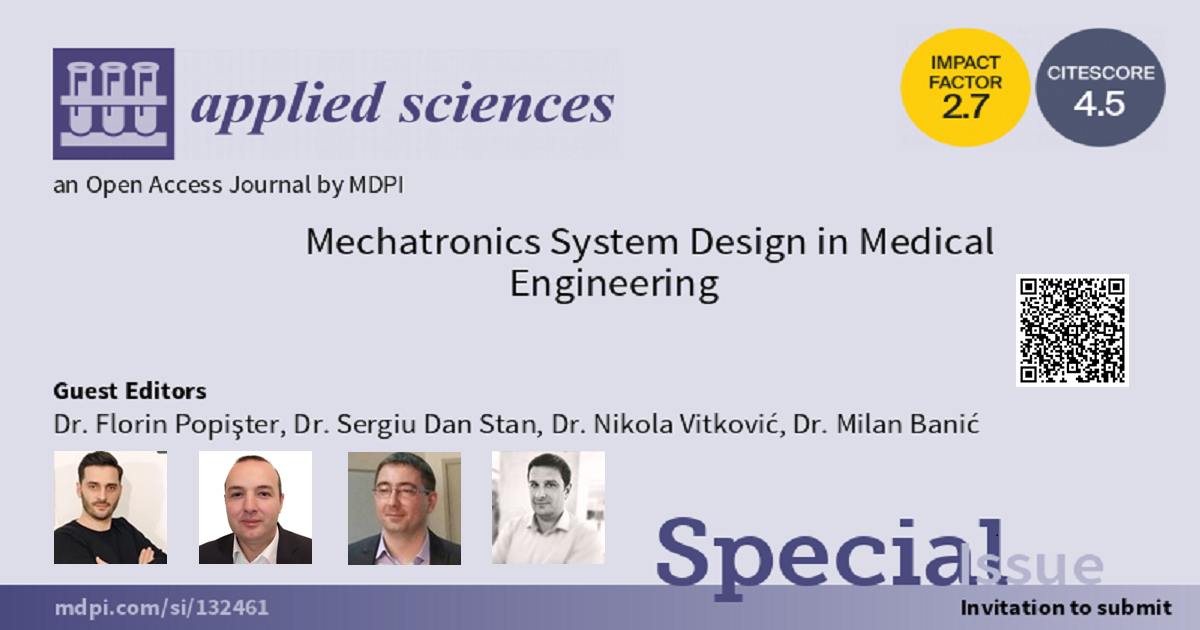Mechatronics System Design in Medical Engineering
A special issue of Applied Sciences (ISSN 2076-3417). This special issue belongs to the section "Mechanical Engineering".
Deadline for manuscript submissions: 30 November 2024 | Viewed by 7334

Special Issue Editors
Interests: graphs; CNC machining; CNC programming; CNC/CAM; reverse engineering; CATIA V5; CMM; digitization; additive manufacturing; CAD-CAM; parallel robots
Interests: mechatronics; parallel robots; robot programming; design of mechatronic systems; CAD; CAM; mechanisms and dynamics of machines; modelling and simulation; MATLAB/Simulink; VR; optimization; genetic algorithms
Special Issues, Collections and Topics in MDPI journals
Interests: geometry; CAD; analysis; mechanical engineering; manufacturing; applied artificial intelligence; programming; computer graphics; Internet Of Things; information systems; reverse engineering; rapid prototyping; biomedical engineering
Interests: finite element analysis; mechanical engineering; structural analysis; finite element modeling; mechanical engineering design; computer-aided design; railway; CAE
Special Issues, Collections and Topics in MDPI journals
Special Issue Information
Dear Colleagues,
This Special Issue focuses on mechatronics systems design, which combines knowledge from electronics, control, materials, manufacturing and modeling to simulate and implement novel products and devices within the medical engineering domain. In order to keep up with the modern trends set by Industry 4.0, with the increased added value of products and systems, advanced technologies and equipment must meet more intensive requirements, necessitating novel research on mechatronic systems in medical engineering.
Mechatronic systems within domains such as manufacturing, programming, prototyping, materials, artificial intelligence, etc., can aid in the development of novel methods, products and practices within medical engineering areas for integration in automatized chains of production or clinical robot design.
Both theoretical and experimental studies are welcome, as well as comprehensive reviews and survey articles.
Topics of interest for this Special Issue include, but are not limited to:
- Mechatronics systems control;
- Programming in control and mechatronics;
- Image processing applied in mechatronics and medical engineering;
- Artificial intelligence applied in mechatronics and medical engineering;
- Modeling and simulation of products in medical engineering;
- Prototyping and deployment;
- CAD/CAM and FEA;
- Additive manufacturing;
- Optimal design of mechatronic systems;
- Redundant parallel robots;
- Reverse engineering in medical applications;
- Modern trends in parallel robots for medical applications;
- Internet of Things in medical engineering;
- Biomaterials used in medical engineering;
- Composite materials for medical structures;
- Monitoring sport and physical activity—measurement and evaluation.
Dr. Florin Popişter
Dr. Sergiu Dan Stan
Dr. Nikola Vitković
Dr. Milan Banić
Guest Editors
Manuscript Submission Information
Manuscripts should be submitted online at www.mdpi.com by registering and logging in to this website. Once you are registered, click here to go to the submission form. Manuscripts can be submitted until the deadline. All submissions that pass pre-check are peer-reviewed. Accepted papers will be published continuously in the journal (as soon as accepted) and will be listed together on the special issue website. Research articles, review articles as well as short communications are invited. For planned papers, a title and short abstract (about 100 words) can be sent to the Editorial Office for announcement on this website.
Submitted manuscripts should not have been published previously, nor be under consideration for publication elsewhere (except conference proceedings papers). All manuscripts are thoroughly refereed through a single-blind peer-review process. A guide for authors and other relevant information for submission of manuscripts is available on the Instructions for Authors page. Applied Sciences is an international peer-reviewed open access semimonthly journal published by MDPI.
Please visit the Instructions for Authors page before submitting a manuscript. The Article Processing Charge (APC) for publication in this open access journal is 2400 CHF (Swiss Francs). Submitted papers should be well formatted and use good English. Authors may use MDPI's English editing service prior to publication or during author revisions.








